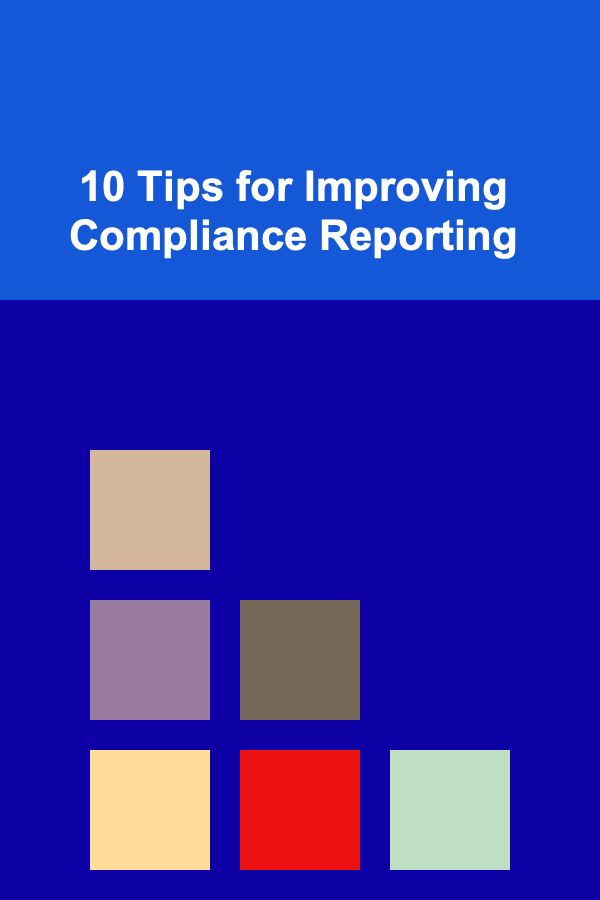
10 Tips for Improving Compliance Reporting
ebook include PDF & Audio bundle (Micro Guide)
$12.99$7.99
Limited Time Offer! Order within the next:

In today's fast-paced business environment, maintaining compliance with a multitude of regulations is crucial. Whether you are part of a small business or a multinational corporation, effective compliance reporting ensures that your organization meets all legal and regulatory obligations, avoids costly fines, and builds trust with stakeholders. However, compliance reporting can be complex, particularly as regulations evolve and businesses expand.
Improving compliance reporting is not just about meeting minimum requirements but optimizing processes to provide clear, accurate, and timely reports. In this article, we will explore 10 tips for improving compliance reporting that can enhance accuracy, efficiency, and effectiveness in meeting compliance standards.
Establish Clear Compliance Objectives
Why It Matters:
Before diving into the details of compliance reporting, it is essential to define clear objectives. Without clear goals, compliance reporting becomes a task that is done only for the sake of fulfilling requirements rather than as a strategic tool for managing risk and ensuring operational integrity.
How to Implement:
- Identify all the regulations that your organization must comply with, such as GDPR, HIPAA, SOX, or industry-specific guidelines.
- Develop a comprehensive compliance roadmap that outlines objectives and how they align with your organization's overall business goals.
- Create measurable targets for compliance performance, such as reducing reporting errors or improving response times for audit requests.
By setting clear compliance objectives, your team will have a roadmap to follow, making compliance reporting more focused, organized, and impactful.
Automate Data Collection and Reporting
Why It Matters:
Manual data collection and reporting can be time-consuming, error-prone, and lead to delays, especially in large organizations that manage extensive data. Automation helps streamline these tasks, reducing human error and increasing efficiency.
How to Implement:
- Use compliance management software that integrates with your existing systems, such as enterprise resource planning (ERP) or customer relationship management (CRM) platforms.
- Implement tools that automatically capture data related to transactions, employee activities, financial records, and any other areas that are relevant to compliance.
- Set up automated alerts for data entry anomalies or compliance breaches to ensure timely corrective actions.
Automation ensures that compliance data is collected consistently and reported on time, helping your organization avoid compliance risks due to human oversight.
Develop a Compliance Reporting Calendar
Why It Matters:
Compliance requirements often come with strict deadlines, and missing them can result in penalties or damage to your company's reputation. A compliance reporting calendar helps keep track of deadlines, preventing any lapses.
How to Implement:
- Create a centralized calendar that tracks all key compliance dates and reporting deadlines.
- Include timelines for both internal and external audits, financial reports, regulatory filings, and other critical milestones.
- Share the calendar across departments to ensure everyone involved in compliance is aware of important dates.
By developing a reporting calendar, you can prevent last-minute scrambles, reduce stress, and ensure that all compliance tasks are completed on time.
Simplify and Standardize Reporting Formats
Why It Matters:
Consistent and standardized reporting formats make it easier to analyze compliance data, spot trends, and compare reports across time periods or departments. It also facilitates better communication with stakeholders, auditors, and regulatory authorities.
How to Implement:
- Create a standardized template for all compliance reports, including sections for data sources, compliance checks, and results.
- Use clear headings, bullet points, and visual aids like charts and graphs to make reports easy to read and understand.
- Ensure that the format is adaptable to different regulations, allowing you to generate reports that meet various compliance requirements with minimal adjustments.
Standardizing formats will save time when preparing reports and ensure consistency in the way data is presented.
Implement Real-Time Monitoring and Alerts
Why It Matters:
Real-time monitoring enables organizations to detect non-compliance issues as they occur rather than waiting until after the fact. This proactive approach can prevent minor issues from escalating into major compliance violations.
How to Implement:
- Use compliance monitoring tools that allow for continuous tracking of relevant metrics in real-time, such as financial transactions, data privacy practices, or security protocols.
- Set up alerts that notify compliance officers or key stakeholders when a compliance threshold is breached or when there is an anomaly.
- Use dashboards to provide a visual representation of real-time data so that you can quickly identify trends or areas of concern.
By implementing real-time monitoring and alerts, you can address compliance risks immediately and minimize the impact of potential violations.
Incorporate Cross-Departmental Collaboration
Why It Matters:
Compliance often spans across multiple departments---legal, finance, HR, operations, and more. Siloed reporting can lead to missed information or misunderstandings. Cross-departmental collaboration ensures that all relevant teams contribute to a comprehensive compliance report.
How to Implement:
- Set up regular meetings between compliance officers, legal advisors, finance teams, and other departments to discuss upcoming reports and share any relevant data.
- Implement collaboration tools such as shared document platforms, project management tools, or compliance management systems that allow for easy sharing of data and insights.
- Ensure that all departments are trained in compliance obligations and understand their role in the reporting process.
Collaboration ensures that all areas of your business are working together towards a common goal and that your reports are comprehensive and accurate.
Regularly Audit and Review Compliance Processes
Why It Matters:
Compliance is not a one-time activity but an ongoing process that needs continuous improvement. Regular audits and reviews of compliance processes help identify weaknesses and areas where improvements can be made.
How to Implement:
- Schedule periodic internal audits to evaluate the effectiveness of your compliance reporting process.
- Use external auditors or consultants to provide an unbiased perspective and identify areas of non-compliance or inefficiencies.
- Implement feedback loops to address the findings from audits and make necessary adjustments to reporting practices.
By regularly reviewing your compliance processes, you can ensure that your reporting remains accurate, efficient, and aligned with evolving regulatory requirements.
Train Employees on Compliance Responsibilities
Why It Matters:
Compliance reporting is not solely the responsibility of the compliance team. Every employee, from top management to entry-level staff, plays a role in ensuring that the organization adheres to regulatory standards. Proper training can help mitigate risks associated with non-compliance.
How to Implement:
- Develop and deliver regular compliance training sessions for employees at all levels, emphasizing the importance of accurate data collection and reporting.
- Ensure that employees understand the specific regulations relevant to their department and job function.
- Provide resources such as handbooks, FAQs, and online courses to make compliance training accessible and engaging.
Employee training helps foster a compliance culture within the organization, ensuring that all team members contribute to the reporting process effectively.
Leverage Advanced Analytics for Data Insights
Why It Matters:
Compliance reporting isn't just about gathering data; it's about analyzing that data to uncover valuable insights. Advanced analytics can identify trends, anomalies, and potential risks that might otherwise go unnoticed.
How to Implement:
- Use data analytics tools to analyze historical compliance data, comparing it against current performance to spot emerging issues.
- Leverage predictive analytics to forecast potential compliance challenges and prepare for them in advance.
- Use visualizations such as heat maps, bar charts, or scatter plots to make complex data more digestible and highlight areas requiring attention.
Analytics can enhance your compliance reporting by turning raw data into actionable insights that guide decision-making and help prevent future compliance issues.
Engage with External Compliance Experts
Why It Matters:
Navigating complex regulations can be difficult, especially as compliance requirements evolve. Engaging with external experts---such as compliance consultants, auditors, and legal advisors---can provide a fresh perspective and ensure that your reporting aligns with the latest standards.
How to Implement:
- Hire external compliance consultants or auditors to review your reporting processes and recommend improvements.
- Stay updated on regulatory changes through partnerships with industry-specific compliance organizations or by attending conferences and workshops.
- Establish a network of external experts that can be consulted when new regulations or compliance challenges arise.
External expertise can provide the guidance needed to ensure your compliance reporting is not only accurate but also aligned with the latest industry standards and legal requirements.
Conclusion
Improving compliance reporting is a continuous process that requires a strategic approach, effective tools, and strong collaboration across departments. By following these 10 tips, organizations can streamline their compliance reporting processes, reduce risks, and ensure timely and accurate submissions to regulatory bodies. Moreover, a proactive and data-driven approach to compliance can help businesses stay ahead of changing regulations, maintain a positive reputation, and avoid costly penalties.
Ultimately, effective compliance reporting is about more than just meeting regulatory requirements; it's about building trust, demonstrating integrity, and fostering a culture of accountability within the organization.
Reading More From Our Other Websites
- [Organization Tip 101] How to Evaluate and Adjust Your Learning Strategies
- [Home Rental Property 101] How to Determine If a Single-Family Home for Rent is Right for You: Space, Privacy, and Responsibilities
- [Home Storage Solution 101] How to Utilize Vertical Space with Smart Hanging Storage Ideas for Your Kitchen Pantry
- [Rock Climbing Tip 101] From Beginner to Pro: The Ultimate Guide to Getting Started at Your Local Climbing Gym
- [Sewing Tip 101] Best Ways to Incorporate Organic Cotton into Quilting
- [Home Soundproofing 101] How to Soundproof a Bathroom to Reduce Noise Pollution
- [Home Space Saving 101] How to Organize Your Culinary Corner: Essential Small Kitchen Storage Ideas
- [Organization Tip 101] How to Encourage Self-Discipline in a Remote Learning Environment
- [Home Holiday Decoration 101] How to Create a Holiday-Inspired Gallery Wall for Your Home
- [Tiny Home Living Tip 101] Best Low‑Maintenance Landscaping Ideas for Tiny Home Communities with Limited Outdoor Space

How to Create a Financial Vision Board for Your Goals
Read More
How to Identify Weak Points in Your Home's Security
Read More
How to Perform DIY Home Maintenance to Save Money
Read More
How to Diversify Your POD Product Offerings
Read More
How To Control Your Data in Online Marketplaces
Read More
How to Identify Antique Postcards: A Beginner's Guide
Read MoreOther Products

How to Create a Financial Vision Board for Your Goals
Read More
How to Identify Weak Points in Your Home's Security
Read More
How to Perform DIY Home Maintenance to Save Money
Read More
How to Diversify Your POD Product Offerings
Read More
How To Control Your Data in Online Marketplaces
Read More